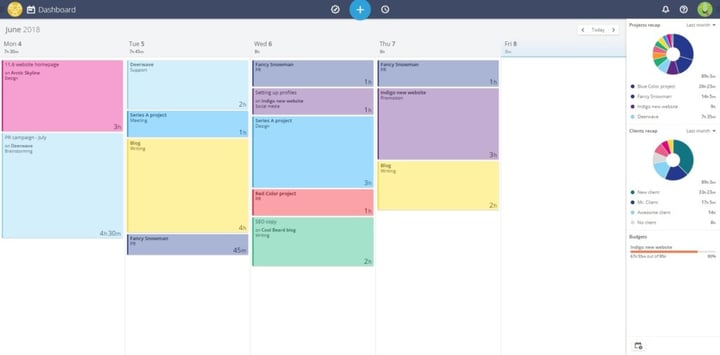Productivity is a matter of organisation and focus. In order to get more things done in a day, you have to know exactly what you need to accomplish and have a clear plan of the things to do.
Things slip away, though, especially in the busiest days of the week. Heavy workloads can make us feel overwhelmed, besides it’s easy to lose track of the bigger picture if we work around the clock.
To avoid this, you could try a different approach by visualising and organising your work.
Helping our brain out
Say that you’ve drafted your plan for the day – you know what projects you should be working on, and the single tasks you need to get done.
Now, instead of keeping everything in your head, you should visualise and organise your tasks. By doing so, you won’t risk leaving something behind, and you’ll never miss the big picture:
Have an assistant for your memory
Memory likes to play dirty and something can simply skip our minds. Keep your to-do written somewhere, and easily accessible, so that you don’t forget something. Also, you’ll be able to review the to-dos in case you need to double-check;
Keep everything in a place
Scattering your work all over the place means losing track of it. If you keep all your to-dos in one place, you’ll keep everything organised and you won’t have problems going back through your work later on;
Have an overview of the work
Knowing your to-dos from start to finish will give you an idea of the workload of the day, and you can change it on-the-go if necessary;
Motivation
Keeping your to-dos right in front of you can also help you feel motivated and ready to tackle the challenges ahead. In fact, crossing tasks from the list generates an instant dopamine release! You can’t deny that if feel good to achieve your goals.
There are several ways in which you can visualize and organize your work. Obviously, everybody works differently and has different productivity habits. So feel free to add your suggestions in the comment box below the article!
The to-do list
The first method is the easiest: the to-do list. The to-do list has a long story: apparently, humanity has been trying to list stuff done since forever. Take a look at this list by Leonardo da Vinci himself:
According to Openculture, the list has been translated and it includes items like:
“Draw Milan”
“Ask Maestro Antonio how mortars are positioned on bastions by day or night.”
“[Examine] the Crossbow of Mastro Giannetto”
“Find a master of hydraulics and get him to tell you how to repair a lock, canal and mill in the Lombard manner”
Amazing, right?
You don’t have to reach a Da Vinci-level of complexity. Just write down your list on a simple notebook, or even a whiteboard, hanging over the wall in front of you.
For those who prefer going digital, several to-do list apps, like Todoist, will help you organized. The upside of going digital is that you can access the list anytime, as long as you have a mobile phone and internet connection at hand.
The Kanban
Kanban is a Japanese word that literally means “signboard” or “billboard”. Originally developed in Japan by Toyota, the Kanban workflow visualization method is used to focus on the process, limit unnecessary tasks and continually improve the system. All the tasks to be performed are written on “cards” that are moved forward according to their status.
You can use the kanban to visualize your workflow and organize tasks in to-do/ doing/ done. Productivity app Trello is the king of digital Kanban boards. It’s easy, visually intuitive, and is used to organize anything, from product launches to weddings. For a more project management-oriented solution, tools like Asana introduced kanban boards view, too, given their popularity and versatility.
The Prioritization Matrix
No plan is completed without clear priorities assigned to every step. Freelancers and creative professions juggling many projects and clients, for example, have to know exactly what needs to be done and in what order, to avoid conflicts and delays.
The Eisenhower matrix is an effective way to sort out important and urgent tasks.
A simple piece of paper or a whiteboard can serve the purpose. Before you start your work day, draw the matrix and put each task on the box so you’ll know which one to tackle first:
-
- Important and urgent: do it right away
- Important, not urgent: schedule a time to do it (and stick to it).
- Urgent, not important: delegate it.
- Not urgent, not important: eliminate it, because nobody likes a crowded list.
The Calendar
Time is a precious resource and yet slips away so easily. Having good time management doesn’t just mean knowing the number of hours worked. It means to know exactly how time has been allocated across your activities and to dedicate that time to the tasks that really matter. It’s an essential step for all those who work against tight deadlines.
For this purpose, I’d suggest trying Google Calendar for scheduling meetings and appointments. Another popular tool is Sunsama, with its half-kanban, half-calendar approach.
As for visualizing the amount of time spent, Timeneye organizes the time tracked in a calendar-style dashboard:

How do you visualize and keep track of your work? Leave your suggestions in the comments. If you seek more productivity hacks, check out this guide to survive busy days – and the tips to drafting a to-do list that actually works.
Give it a try and sign up for a free 30-day Timeneye trial!